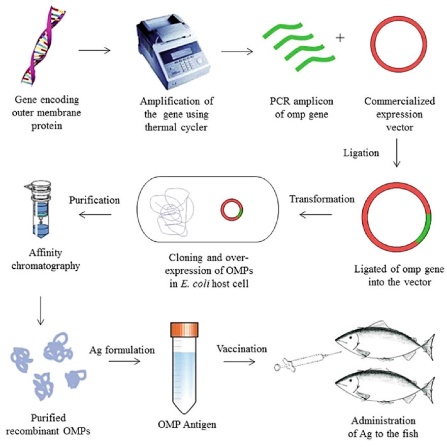
LIFE BELOW WATER
INTRODUCTION
.png) |
Oceans provide key natural resources, including food, medicines, biofuels, and other products. Over three billion people depend on marine and coastal biodiversity for their livelihoods. Our rainwater, drinking water, weather, climate, coastlines, much of our food, and even the oxygen in the air we breathe, are all ultimately provided and regulated by the sea. Oceans cover three-quarters of the Earth’s surface oceans provide key natural resources, including food, medicines, biofuels, and other products. Over three billion people depend on marine and coastal biodiversity for their livelihoods. Our rainwater, drinking water, weather, climate, coastlines, much of our food, and even the oxygen in the air we breathe, are all ultimately provided and regulated by the sea. Oceans cover three-quarters of the Earth’s surface.
Water provides the key to natural resources, including food, medicines, biofuels, and other products. Over three billion people bank on coastal biodiversity for their living. Oceans cover three-quarters of the earth’s surface. Increasing amounts of waste in the ocean have a major impact on the environment. The damage cannot be reversed, but effort must be made to prevent further exploitation. Nitte (DU) awareness programs are conducted to minimize the severity of the problem.
Use, Reuse, and Recycle continued to be implemented in Nitte (DU). Water retaining material like cloth/gunny bags etc, during curing, Ponding for retaining water on flat concrete structures for curing, curing chemicals/ techniques to minimize water requirements, nonpotable water (STP) for construction activities, water-efficient plumbing fixtures like pushcock taps, sensor-based taps, aerators, pressure inhibitors, and flow regulators for ensuring constant flow, Separate pipelines for potable water, water for recycling and treated water are provisioned for during construction, provision for rainwater harvesting, provision for management of stormwater, rainwater storage ponds have been created in the campus for storage of stormwater, rainwater from an artificially created storage pond from an external location near the campus is used. A MoU has been signed with the land-owner for the use of this water, the use of recycled water for flushing and gardening, and reminder boards to save water.
Research publications of 2022- Aditya V, Kotian A, Saikrishnan S, Rohit A, Mithoor D, Karunasagar I, Deekshit VK. Effect of ciprofloxacin and in-vitro gut conditions on biofilm of Escherichia coli isolated from clinical and environmental sources. Journal of Applied Microbiology. 2022 Feb;132(2):964- 977. doi.org/10.1111/jam.15249
- Apine E, Mani MK, Rai P, Karunasagar I, Turner LM. Future Climate Change Conditions May Compromise Metabolic Performance in Juveniles of the Mud Crab Scylla serrata. Journal of Marine Science and Engineering. 2022 April ; 10(5):582.doi.org/10.3390/ jmse10050582
- Yathisha UG, Srinivasa MG, Siddappa BC R, Mandal SP, Dixit SR, Pujar GV, BS.M. Isolation and characterization of ACE-I inhibitory peptides from ribbonfish for a potential inhibitor of the main protease of SARS-CoV-2; an in-silico analysis. Proteins: Structure, Function, and Bioinformatics. 2022 April; 90(4):982-992. doi.org/10.1002/ prot.26291
- Caputo, Andrea; Bondad-Reantaso, Melba G.; Karunasagar, Iddya; Hao, Bin; Gaunt, Patricia; Verner-Jeffreys, David; Fridman, Sophie; Dorado-Garcia, Alejandro. Antimicrobial resistance in aquaculture: A global analysis of literature and national action plans. 2023; Reviews In Aquaculture.
- Chetan D.M., Raghavendra H.L., Bhat R.S., Kumar N.S., Kamath V.H. Assessment Of Physicochemical Characteristics Of Various Water Sources. 2022 ; Journal of Pharmaceutical Negative Results
- D’Souza S.L., D’Souza N., Shenoy K.B. Molluscan diversity of coastal Karnataka, India, and role of physicochemical parameters on their diversity.2022; Journal Of Coastal Conservation.
- Dechamma MM, Santhosh KS, Maiti B, Karunasagar I, Karunasagar I. Application of novel lytic bacteriophages to control Vibrio parahaemolyticus load in seafood. Journal of Consumer Protection and Food Safety 2022 March; 17(1):41–49 .doi.org/10.1007/ s00003-021-01356-
- Deekshit, Vijaya Kumar; Maiti, Biswajit; Kumar, Ballamoole Krishna; Kotian, Akshatha; Pinto, Gillaine; Bondad-Reantaso, Melba G.; Karunasagar, Iddya; Karunasagar, Indrani. Antimicrobial Resistance In Fish Pathogens And Alternative Risk Mitigation Strategies. 2022; Reviews In Aquaculture.
- Divyashree M, Mani MK, Karunasagar I. Association of exopolysaccharide genes in biofilm developing antibiotic-resistant Pseudomonas aeruginosa from hospital wastewater. Journal of Water and Health. 2022 Jan; 20 (1):176–184. doi: 10.2166/ wh.2021.223.
- Dubey S, Anger-Wick E, Kumar J, Karunasagar I, Karunasagar I, Peng B, Evensen Ø, Sørum H, Munang’andu HM. Aeromonas species isolated from aquatic organisms, insects, chicken, and humans in India show similar antimicrobial resistance profiles. Frontiers in Microbiology.2022 Dec;13 : 1008870. doi: 10.3389/fmicb.2022.1008870
- Ghate S.D., Kallappa G.S., Nagaraju V.T., Patil P.K. High-throughput sequencing-based analysis of bacterial communities associated with the gut microbiota of Indian and Pacific white shrimp. 2022; Korean Journal Of Microbiology.
- Goveas, Louella Concepta; Selvaraj, Raja; Sajankila, Shyama Prasad.Characterization of biosurfactant produced in response to petroleum crude oil stress by Bacillus sp. WD22 in marine environment.2022; Brazilian Journal Of Microbiology
- Morajkar, S., Suneetha, C., Harish Kumar. T.G., Hegde, S. Molecular markers in pteridophytes In: Ferns - propagation, biotechnology, medicinal use and environmental regulation (Eds) Johnson M, Helena Fernández, Ashwani Kumar, Shibila T. 2022 (pp. 99-134) Springer. ISBN 978-981-16-6169-3
- Murugaiyan J, Kumar PA, Rao GS, Iskandar K, Hawser S, Hays JP, Mohsen Y, Adukkadukkam S, Awuah WA, Jose RAM, Sylvia N, Nansubuga EP, Tilocca B, Roncada P, Roson-Calero N, Moreno-Morales J, Amin R, Kumar BK, Kumar A, Toufik A-R, Zaw TN, Akinwotu OO, Satyaseela MP, van Dongen MBM. Progress in Alternative Strategies to Combat Antimicrobial Resistance: Focus on Antibiotics. Antibiotics. 2022 Feb.;11(2):200. doi. Org /10 .3390/ antibiotics 11020200
- Narayan, Prajna; Jacob, Ankeeta Menona; Shetty, Pranav; Singh, Preethika. A Comparative Study on the Knowledge, Attitude, and Perception toward Hazardous Medical Waste Produced at Home in a Coastal City of Karnataka, India. 2022; Journal of Health and Allied Sciences NU.
- Nayak A, Karunasagar I, Chakraborty A, Maiti B. Potential application of bacteriocins for sustainable aquaculture. Reviews in Aquaculture. 2022 June;14(3): 1234-1248. doi.org/10.1111/raq.12647
- Poojari K, Akhila DS, Raj JM, Santhosh KS, Kenjar A, Ashwath P. Biocontrol of Escherichia coli and Salmonella in poultry meat using phage cocktail. Iranian Journal of Veterinary Research. 2022;23(3):270–274. doi: 10.22099/ IJVR.2022.41490.6030
- Prabhakara AM, Nanjappa DP, Kotian A, Kalladka K, Chakraborty G, Vittal R, Raj JR, Deekshit VK, Chakraborty A. Wild-type and cancer-prone zebrafish exhibit distinct gut microbial diversity and differential antiinflammatory response upon infection. Journal of Biosciences. 2022 Dec;47(4): 65. doi.org/10.1007/s12038-022-00302-6
- Prabhu, S., Hegde, S. Pteridophytes as effective biosorption agents of heavy metals. In: Ferns - propagation, biotechnology, medicinal use and environmental regulation (Eds) Johnson M, Helena Fernández, Ashwani Kumar, Shibila T .2022(pp. 651-670). Springer. ISBN 978-981-16-6169-3
- Sajeev S, Roshni PT, Mathias RC, Morajkar S, Prabhu S, Hegde S. Pteridophytes: effective agents of phytoremediation In: Ferns - propagation, biotechnology, medicinal use and environmental regulation (Eds) Johnson M, Helena Fernández, Ashwani Kumar, Shibila T. 2022 .(pp. 627-649). Springer. 978- ISBN 981-16-6169-3
- Suneetha C, Hegde S. Micropropagation of pteridophytes In: Ferns - propagation, biotechnology, medicinal use and environmental regulation (Eds) Johnson M, Helena Fernández, Ashwani Kumar, Shibila T. 2022(pp. 201-242) Springer. ISBN 978-981- 16-6169-3
- Yathisha UG, Vaidya S, Sheshappa MB. Functional Properties of Protein Hydrolyzate from Ribbon Fish (Lepturacanthus Savala) as Prepared by Enzymatic Hydrolysis. International Journal of Food Properties .2022 March ;25(1) :187-203. doi.org /10.1080/10942912.2022.2027964
Primary area of research
.jpg)
Externally funded research project at Nitte (DU)
.jpg)
.jpg)
.jpg)
.jpg)
International collaboration on disease prevention in aquaculture
Nitte DU is involved through an ongoing research project with the Norwegian University of Life Science, Oslo, to explore biotechnological approaches to prevent and control fish disease in aquaculture (BIOAQUA). This ongoing project has been financially supported by the Department of Science & Technology (DST), Government of India, with a budget of Rs. 45 lakhs. The aim is to promote scientific renewal and development of disciplines and/or to generate new knowledge about issues relevant to both societies in mutually agreed fields and to achieve bilateral world-class scientific results in the field of bioeconomy.
Research on the Defence genes of Tiger shrimps (Penaeus monodon) with respect to bacteria (Vibrio harveyi) and white spot syndrome virus (WSSV) infection is undertaken by Prof. Indrani Karunasagar in collaboration with Prof Peter Bossier of Ghent University.
A regional workshop was organization on mitigation of antimicrobial resistance (AMR) risk from aquaculture in Asia: awareness raising and policy dialogue, supported by the Food and Agriculture Org. of the United Nations (FAO-UN)
.jpg)
Government of India supported academic program on Marine Biotechnology DBT sponsored postgraduate program on Marine Biotechnology
Nitte (Deemed to be University) introduced a new postgraduate program, sponsored by the Department of Biotechnology, Government of India. In the year 2020, the Ministry of Science & Technology, Department of Biotechnology (DBT), Govt. of India has approved Nitte University Centre for Science Education & Research (NUCSER) to offer a Master of Science in Marine Biotechnology. This recognition is awarded by the DBT which will sponsor ten students with a national fellowship. Students are selected through a National Level Graduate Aptitude Test- Biotechnology (GAT-B) for all Biotechnologyrelated courses in India. The goal of this program is to provide appropriate laboratory and communication skills for the development of various technologies and implement the needs of the economy through entrepreneurship, study the marine environmental systems and fisheries, support the industrial sector by promoting the relevant applications and development of the marine biotechnological process, train and empower youth mind to develop the sustainable strategy of harnessing the marine environment for food, medicines, and other resources.
Outreach programs A Program on water conservation under the SDG initiatives of the UniversityUnder the Sustainable Development Goals initiative of the University, Nitte University Centre for Science Education & Research, Nitte (Deemed to be University) conducted a program on “Water conservation and Irrigation practices for the farmers” at Rotary Convention Hall, Kinnigoli on 27th September 2022 in association with the Department of Horticulture, Mangaluru and the Rotary Club Kinnigoli. Mr. Shree Padre, Editor, Adike Patrike was the resource person. Farmers, school children, postgraduate students, teaching, and non-teaching staff of NUCSER attended the program. Mr. Devidas Shetty, President of the Rotary Club welcomed the gathering and gave the opening remarks. The Nitte Institution Innovation Council president, Prof. Dr. G. Srinikethan inaugurated the program. Prof. Dr. Anirban Chakraborty, Director, NUCSER explained the importance of the sustainable development program and the initiatives of Nitte University. The guest speaker was welcomed by Prof. Dr. Smitha Hegde, Deputy Director, NUCSER, and was facilitated by Nitte University in association with the Rotary Club. The CEO of Pattana panchayat, Kinnigoli, Mr. Sayeesh Chowta stressed upon the water problems faced by the local farmers due to the failure of wells resulting from groundwater depletion. He acknowledged the gesture of the organizers for conducting the program at Kinnigoli.
Mr. Shree Padre highlighted the importance of water in every sector of the community. He focused his talk on the process and the technologies of rainwater harvesting. Students and participants raised certain questions, which were answered by a resource person. Mr. K Praveen, Senior Assistant Director of Horticulture explained the government schemes available for irrigation. Dr. Akhila D.S., Assistant Professor NUCSER coordinated the program and proposed the vote of thanks.
.jpg)
Outreach program: Bamboo shoot planting at the river bank
An outreach program for bamboo shoot planting at the bank of Payaswini River, Iriyanni, Kasaragod was conducted by the Nitte University Green Initiative Programme (NUGIP) in association with and Youth Red Cross Unit, NUCSER in association with Iriyanni Govt. Vocational Higher Secondary School, Muliyar on 2nd July, 2022. Students from UG, PG, as well as Ph.D. in a total of 16 students, along with four faculty members, attended the program. We were received by Mr. Sajeevan Madaparambathu, Principal, Govt. Higher Secondary School, Iriyanni along with his students under the NSS Unit. We planted bamboo shoots near the riverbed and headed straight to Govt. HSS, Iriyanni. All the faculties and students of the school welcomed us warmly. An interactive session on Freshwater Turtles, especially on a rare species Cantor’s giant softshell turtle (Pelochelys cantorii), found exclusively in the Chandragiri River, was organized and Mr. Nandan Vijayakumar, a wildlife conservationist was the resource person. Shri C. H. Kunhambu, MLA of Udma, Kasaragod, visited the school. He gave a short speech and planted trees along with the NSS students of the school. Prof. Dr. Smitha Hegde, Deputy Director of NUCSER, thanked and presented a small token of gratitude to the resource person and the organizers behind this program at the school.
.jpg)
Awareness programs
Walk along to make a difference “ Save our Oceans-2022”
A walkathon “SAVE OUR OCEANS’’ was organized to create awareness about the protection of our oceans on 18.12.2022 from Paneer Campus to Someshwar Beach, Mangaluru. The walkathon was hosted by Nitte (DU) in association with NUCSER, NSS unit, and Kotekar Pattana Panchayat, Mangaluru. The flag-off was done by the guests of eminence, Honourable Vice Chancellor Prof Dr. Satheesh Kumar Bhandary, Pro VC Dr. MS Moodithaya, Registrar of the University Dr. Harsha Halahalli, Advisor (Patents) of Nitte (Du) Prof. Dr. Iddya Karunasagar, Head ICAR-CMFRI, Mangaluru, Dr. Dinesh Babu, The Aquatic Biosystems Dr. Ashwin Rai and Dr. Ronald D’SOuza. The Vice Chancellor of Nitte (Du) highlighted the importance of such a walkathon in the coastal regions of Mangaluru and inspired everyone to be a part of it. The Director of NUCSER Prof Dr. Anirban Chakraborty welcomed the guests, and the Deputy Director Dr. Smitha Hegde thanked the guests and participants for their presence.
Over 200 participants took part in the event, and the walk began from the entrance of Paneer Campus at 7:30 AM and completed at Someshwara Beach at around 9:00 AM. The participants were holding posters made by them and shouting out slogans throughout the walk to bring attention to the motto of saving our oceans. The walk was constantly supervised by the police, who ensured our safety throughout the event. All the participants were felicitated with a medal and a certificate upon reaching the endpoint.
.jpg)
A session on Sustainable Development Goals (SDG-14) by YRC Unit on ‘Marine Turtles: The Life Around the Sea
A session on Sustainable Development Goals (SDG-14) on ‘Marine Turtles: The Life Around the Sea’ was conducted on 28th June 2022 on behalf of Youth Red Cross (YRC) Unit, NUCSER at the University auditorium, Paneer campus, Nitte DU. Mr. P. V. Sudheer Kumar, Secretary, of Naithal, was the resource person. The formal programme started at 11:00 AM with a welcome address by the Deputy Director Prof. (Dr.) Smitha Hegde followed by the introduction of the resource person by Dr Madhu K. Mani, YRC Unit, Member Secretary. The Guest of Honour, Mrs. Latha S., YRC Co-ordinator of Nitte DU, felicitated the programme. NUCSER Director, Prof. (Dr.) Anirban Chakraborty delivered the presidential address. The formal programme ended by 11:30 AM for a tea break after the vote of thanks by Ms Jipsa Ann Philip, Student Vice-Chairman, YRC Unit.
Mr. P.V. Sudheer Kumar has been the part of Naithal, an NGO, that works for the conservation of sea turtles registered at Nileshwaram, Kasaragod district of Kerala for the last 23 years. Mr. Sudheer Kumar spoke on different species of Turtles found in various parts of the world. He also added about their life cycle, reproduction, nesting, the role of temperature in the determination of the sex of the Turtles and the hurdles faced by the offspring from hatching till their way back to the shore. He explained about the paramount effort of their organization from collecting the eggs from the beach, providing the hatching facility and finally releasing the hatchlings to the sea. At the end of the session, he shared a documentary video conducted by his organization regarding the arrival of sea turtles to the mother shore for laying eggs, collection of eggs and keeping at protected hatching places at the beach territory, and releasing the offspring back to the sea once they are hatched.
.jpg)
International Day for ‘Conservation of the Mangrove Ecosystem’
A session on celebrating the International Day on the ‘Conservation of the Mangrove Ecosystem by Prof. (Dr.) Shivakumar Magada, Dean, College of Fisheries, Mangaluru was organized by NUCSER under Sustainable Development Goals (SDG-14) on 26th July 2022 at the University auditorium, Paneer campus, Nitte (DU). The formal programme as scheduled started at 2.30 PM with a welcome address by the Deputy Director and Coordinator of NUGIP, Prof. (Dr.) Smitha Hegde. Prof. (Dr.) Anirban Chakraborty, Director (NUCSER) introduced the resource person to the participants. Prof. Shivakumar spoke about India’s largest mangrove forest, the Sundarbans on the Ganges Delta. He illustrated the sustainable marshy, halophytic environment of mangrove forests along with the adaptations of plants, and modification of leaves, seeds, and roots for survival in the estuarine ecosystem. The formal program concludes with a vote of thanks rendered by Dr. Madhu K. Mani, Member Secretary, YRC Unit, NUCSER. A memento was given to Prof. Shivakumar by Prof. Anirban Chakraborty as a token of our gratitude to the resource person and his scholarly talk on the Mangrove ecosystem. Research scholars, students, and teaching, and non-teaching faculty members attended the lecture and took part in the interactive session post-lecture. The program was attended by 110 participants.
.jpg)
Water-sensitive waste disposal
Water sampling- All students, employees, and visitors in the centers of Nitte (DU) have free access to clean drinking water. Drinking water is available through UV-based water purifier dispensers. The quality of water is assessed periodically through both in-house and external testing. The quality of the various water sources including drinking water available in the University campus is periodically sampled and tested for various chemical and microbial parameters. This contributes to a healthy campus. All major buildings have separate storage facilities for potable and non-potable water. Segregated storage tanks and pipelines are available for potable water, stormwater, and grey water.
Water RecyclingThe rainfall pattern in Mangalore is erratic, and therefore, the water from the Nethravathi River and ground-water sources is not available in adequate quantity. With an increase in patient footfalls and an expansion in the number of student admissions, the demand for water has considerably increased. The groundwater levels have fallen with poor levels of recharge. Therefore, it has become necessary to look for alternatives. Since most of the water supply returns to the sewerage system (80%), the disposal of such contaminated wastewater is another issue. To address these issues, as a socially conscious and responsible Higher Educational Institution (HEI), Nitte (DU) is taking several steps, and one among them is the Policy on the reuse of treated wastewater. This Policy, if implemented, will reduce the stress and over-dependence on the freshwater for non-potable purposes also.
.jpg)
The reducing trends of the water resources and the concept of treated wastewater recycling and reuse have caught the attention of university officials. Since this technology is now a matured one, it is a plausible and feasible one to address the issue of reduction in the usage of freshwater resources. The citizen’s responsibility towards the environment is mentioned in the Constitution of India. The Water (Prevention and Control) Act 1986, addresses the need for wastewater treatment and subsequent use for non-potable purposes. This Policy is therefore framed keeping in view the provisions in the Constitution of India and the Statutes and policies of MoEF, CPCB, KSPCB, and other regulatory bodies.
.jpg)
Watershed management strategy Have implemented a watershed management strategy based on the location-specific diversity of aquatic species.
Being located in a region that receives high rainfall during the monsoon season, Nitte DU makes efforts to manage and utilize rainwater effectively. Stormwater drains separate from the general drainage system are in place.
Rainwater from roofs is collected using separate pipelines. This water is collected in raw water storage tanks which are then treated in a WTP consisting of a pressure sand filter and activated carbon filter. Additionally, the chlorine demand of the water is assessed and the required dosage (Sodium hypochlorite diluted to 10%) is provided using automatic dosage pumps. The water is used for all domestic purposes.
The volume of rainwater in the three campuses is as follows:Justice K S Hegde Charitable Hospital: Approx. 2 lakhs litres of rainwater is collected with a heavy shower of 30 mins
KSHEMA: Approx. 1.5 lakh liters of rainwater is collected with a heavy shower of 30 mins
Paneer campus: Approx. 1 lakh liter of rainwater is collected with a heavy shower of 30 mins
.jpg)
Student involvement in nurturing aquatic ecosystem conservation:
In Nitte (DU), modules are inculcated to educate the faculty and students. Classroom activities to explore the ideas of how to use the ocean sustainably will be explored. Backed up with a strong research team more projects will be undertaken. As we are housed in coastal areas, the conservation of marine areas can be easily employed. We at NitteDU believe and abide by “Live and let live” Be it human beings or a tiny fish, every being is provided the utmost care.
Oceans cover almost 70% of Earth’s surface area and are responsible for 70% of Earth’s oxygen production. The marine environment represents a complex, diverse, and dynamic ecosystem that serves as a source of food and other resources. However, due to land-based anthropogenic activities including urbanization, capture fisheries, industrial developments, and tourism, there is a constant pressure on the marine ecosystem to protect its diversity in terms of form, structure, physiology, and chemistry. Among the many threats that are currently challenging the existence of the dynamism that a marine ecosystem truly reflects; plastics represent the single largest threat in today’s context. Thus, it is necessary to create awareness of ways to prevent and reduce marine pollution in order to protect the ecosystem for future generations. Schools and colleges play a major role in this regard because young people spend a large time with peers in educational institutions.
Nitte (DU) is committed to educating the stakeholders of the society on issues of marine pollution and about the measures that can be implemented to prevent and reduce the pollution of marine ecosystems.
Coastal Clean-up Day “International Coastal Clean-up Day”Coastal Clean-up Day International Coastal Clean-up Day is celebrated on the third Saturday of September under the aegis of “Azadika Amrit Mahotsav”. This year on 17th September 2022, a mega awareness campaign was organized with various departments and ministries of the Government of India in collaboration with Civil Society organizations from across the country. Nitte Institute of Physiotherapy, along with other educational institutions and local organizations participated in the event and gave complete cooperation and support to the campaign held at Ullal Beach on Saturday from 7 am to 10 am. More than 70 student volunteers along with faculties of NIPT participated.
.jpg)
In NitteDU, modules are involved to educate the faculty and students on the same. Classroom activities to explore the ideas of how to use the ocean sustainably will be explored. More outreach programs will be conducted. As we are housed in coastal areas, the conservation of marine areas can be easily employed. These changes, if inculcated, will unquestionably mitigate the impact of climate change. We at Nitte (DU) believe and abide by “Live and let live” Be it human beings or a tiny fish, every being is provided the utmost care.
Monitoring the health of aquatic ecosystems Groundwater analysisIn India, groundwater is highly polluted with chemicals that runoff from industrial and agricultural wastes, and microbial contamination arises due to sewage contamination. Routine monitoring of groundwater would provide for surveillance and timely intervention to mitigate further damages. Increased anthropogenic activities have caused a drastic increase in both chemicals and microbial pollution in fresh waters. Groundwater samples from various locations in Mangalore were collected and tested for the presence of chemical parameters beyond permissible limits and microbiological quality.
Analysis of Chemical ParametersHeavy metals interferes with the normal physiology of the human body. It binds to cellular components, leading to dysfunction of the metabolic processes in our body. This study was undertaken to study the geospatial distribution of selected heavy metals in openwell waters within Mangalore City Corporation limits. Water samples were collected from all 60 wards in the jurisdiction of Mangalore City Corporation. The fluoride concentration was estimated using the spectrophotometric method using the Sodium 2-(parasulfophenylazo) -1,8-dihydroxy3,6-naphthalene disulfonate (SPADNS) reagent. Similarly, iron was estimated using the phenanthroline reagent. The findings report that the pH of the samples was acidic in 20 wards. Panambur, Kunjathbail North, Mannagudda, Court, and Cantonment water were colored. Kunjathbail (North), Kunjathbail (South), Kambala, Kadri North, Bendoor, Bolar, Mannagudda, and Markada, showed high turbidity levels. The fluoride concentration in the samples collected from 60 wards of Mangalore city was less than 1.5 ppm, which is the permissible limit by the World Health Organization. Iron is within the permissible limit except for the wards Court and Boloor, which showed an iron concentration of 0.4 ppm and 3.08 ppm, respectively. However, arsenic was not detected in any of the 180 samples collected from the 60 wards of Mangalore City Corporation.
Microbiological analysisWater samples from various locations in Mangalore city were sampled and tested for potability, fecal coliforms, and total coliforms. In cases where the water was found to be contaminated, corrective measures were suggested. Follow-up analyses were also conducted to monitor the quality. The biodiversity of the water body in the upcoming Nitte campus was also studied.
.jpg)
NUCSER organizes a session on “Liveable World with Good Aquatic Stewardship Practices”
Under the Sustainable Development Goals initiative of the University, Nitte University Centre for Science Education & Research, Nitte (Deemed to be University), in association with the Department of Fisheries, Dakshina Kannada, GoK, conducted a program on “Good Aquatic Stewardship practices’’ at university auditorium, Paneer, on 30th Nov 2022. Mr. Hemraj Salian, Managing Partner of Riverside Farm, Mulki, was the resource person who talked about his experiences with cage farming and about the importance of aquaculture in the society, and its benefits in every sector of the community. He also advised the students to take up such entrepreneurship ventures that are highly lucrative. Prof. Iddya Karunasaagr, Advisor (Research and Patents), Nitte (DU) was the chief guest, and Dr. Sushmita Rao, Deputy Director, Department of Fisheries, Gok was the guest of honor. Prof. Dr. Anirban Chakraborty, Director, NUCSER, explained the importance of the sustainable development program and the initiatives of Nitte University in his opening remarks and also welcomed the invited dignitaries. Dr. Sushmitha Rao highlighted the different schemes for aqua farming and the support given to Mr. Hemraj through the government schemes.
On this occasion, Mr. Hemraj Salian was also felicitated by the University for the best sustainable aquaculture practices on his farm. Postgraduate students, teaching, and nonteaching staff of NUCSER attended the program. Dr. Gunimala Chakraborty, Dr. Juliet Mohan Raj, and Dr. Rajeshwari Vittal, faculty members of NUCSER, coordinated the program.
.jpg)
.jpg)
Collaborate with the local community in efforts to maintain shared aquatic ecosystems
- Rainwater from an artificially created storage pond from an external location near the campus is used. A MoU has been signed with the land owner for the use of this water
- Promotion of rainwater harvesting offcampus – Nitte DU purchases rainwater via a dedicated pipeline from an artificially created rainwater harvesting pond from an external location near the campus. This promotes rainwater harvesting storage at this off-campus location.
Research on aquatic ecosystem
- Metagenomic Approaches to Identify Fish Gut Microbiome and the Effect of Prebiotic Supplements on Gut Microbes and Health Management
Aquatic environment is a complex ecosystem comprising various flora and fauna. Aquaculture ecosystem represents a closed system that is used to maximize fish production for food. Thus, maintenance of proper conditions in this dynamic ecosystem is very crucial as an imbalance could prove detrimental to the cultured species leading to economic losses. The connection of the gut microbiome with the general well-being of an animal has been widely studied and indeed, dysbiosis of the gut microbiome is signature for many infectious and non-infectious diseases. Colonization of the gut by beneficial bacteria is directly linked to the health of the organism. This paper summarized the various studies that looked at gut microbiomes through culture-independent method (metagenome) and how addition of certain supplements that are known to enhance the growth of beneficial bacteria in the gut reflected positively on the growth of the cultured species. 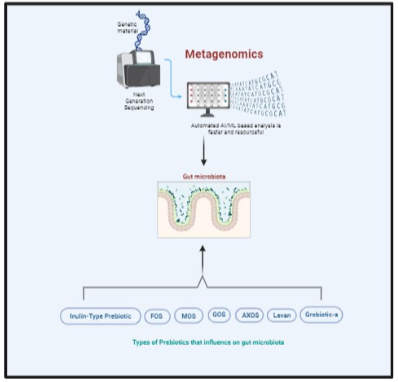
-
Potential application of bacteriocins for sustainable aquaculture
Aquaculture is one of the fastest-growing food-producing sectors globally, and fish is considered essential, both for food and nutritional security, as it is the best source of protein.However, emergence of diseases due to pathogenic microorganisms result in disease outbreaks leading to the collapse of the natural aquatic ecosystem. Use of antimicrobials is associated with the emergence of resistance in bacteria and the subsequent transfer of these traits to humans from the environment through the food chain. Probiotic bacteria are beneficial bacteria that can prevent the growth of pathogenic organisms through secreted molecules. One such compound is bacteriocin, which can potentially be utilized as an alternative to traditional antibiotics or other strategies of disease prevention. This approach can be safe and can maintain the aquatic ecosystem. 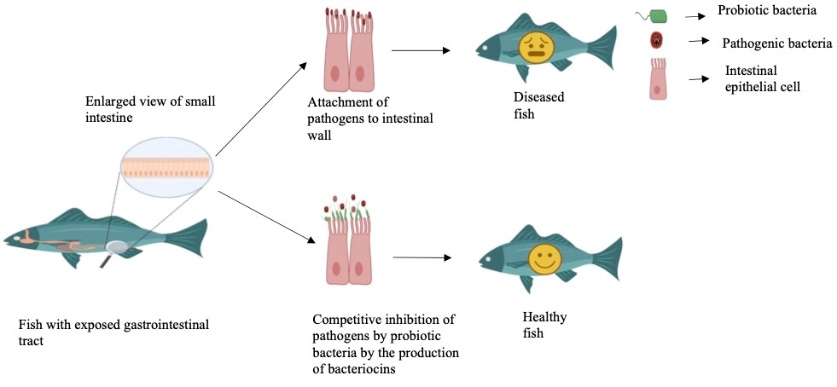
-
“Clinical, Epidemiological and Microbiological Profile of A Potentially Pathogenic Environmental Saprophyte, Burkholderia pseudomallei; at A Tertiary Care Hospital in Coastal India”
This study focused on how an environmental isolate can become pathogenic to human beings if there is an imbalance in the natural ecosystem and what are the manifestations of the disease caused by a bacterium that is a natural inhabitant of the environment. 
-
“Future Climate Change Conditions May Compromise Metabolic Performance in Juveniles of the Mud Crab Scylla serrata”
This study showed how an imbalance in ecological parameters such as salinity and temperature, two crucial parameters linked to marine climate change could affect the metabolic rate of crabs, whose early life stages are directly are known to be particularly vulnerable to both the direct physiological effects of climate change and exposure to harmful microorganisms. The study shows the effect on the biodiversity of important animals in the marine food chain. 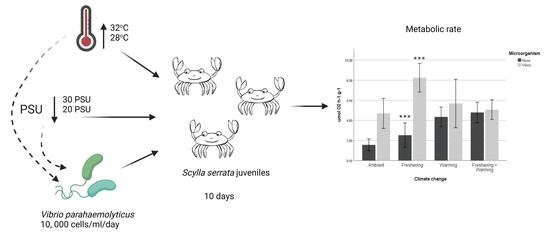
-
“Concise review on bacterial degradation of petroleum hydrocarbons: Emphasis on Indian marine environment”
This paper summarizes the advantages of bioremediation involving microorganisms in handling marine pollution due to oil spills over other physical and chemical methods. The paper describes the utility of petroleum-degrading bacteria in managing oil spills and how these microorganisms can be utilized for protecting marine health. 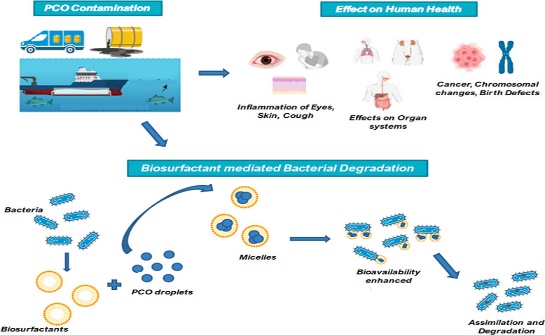
- “Nitrogen dependence of rhamnolipid mediated degradation of petroleum crude oil by indigenous Pseudomonas sp. WD23 in seawater”
This study aimed at degradation of petroleum crude oil by an indigenous Pseudomonas sp. WD23 in sea water that has the ability to produce a biosurfactant called rhamnolipid. It emphasized the need for bioremediation strategies involving microorganisms in ocean oil spills. The paper describes the utility of a petroleum-degrading bacteria that is naturally present in marine systems in managing oil spills and how this microorganism can be utilized in protecting marine health during oil spills. 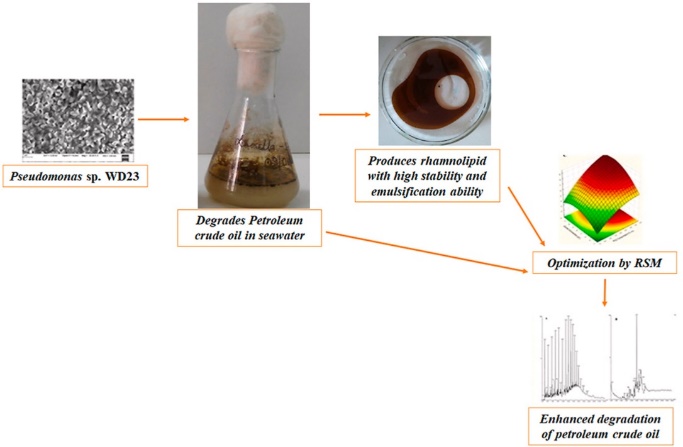
-
“Characterization of biosurfactant produced in response to petroleum crude oil stress by Bacillus sp. WD22 in marine environment”
This study looked at the ability of a bacteria, Bacillus sp. WD22, isolated from a refinery effluent, to degrade petroleum crude oil through a biosurfactant that is produced by this bacterium. The study looked at the characterization of biosurfactants. Highlights the concept of bioremediation in managing marine ecosystems. 
-
“Biotechnological Advances in the Development of Outer Membrane Protein-Based Vaccines for Use in Aquaculture”
Aquaculture is a highly dynamic ecosystem and marine aquaculture means culturing the target species in enclosures that are placed in a natural environment to have a near normal marine environment. However, disease outbreaks are a major challenge that can destroy the entire flora and fauna. This paper describes how certain immunogenic proteins of pathogenic bacteria can be utilized as potential vaccine candidates for preventing economic losses due to disease outbreaks in marine aquaculture. 